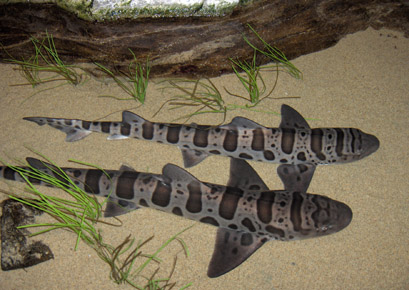Although it’s part of my day job, even in social situations I enjoy asking the icebreaker, “What sharks do you think live in San Francisco Bay?”

No two leopard sharks have the same pattern of markings. Photo Courtesy of Aquarium of the Bay
By Kati Schmidt
Published: May, 2011
Although it’s part of my day job, even in social situations I enjoy asking the icebreaker, “What sharks do you think live in San Francisco Bay?” The question receives a mix of reactions, most commonly of the blank stare variety. Never fear, I’m here to help — there are five species of sharks commonly found in San Francisco Bay: sevengill, soupfin, spiny dogfish, brown smoothhound and the most common, the leopard shark, Triakis semifasciata.
Leopard sharks have an elongated, gray to brown body with distinct dark saddle bars on its back and sides—no two leopard sharks have the same pattern. The average length of a leopard shark is four to five feet long. “Even though leopard sharks are common in San Francisco Bay, their beautiful patterns are very unusual for sharks,” said Christina J. Slager, director of husbandry at Aquarium of the Bay.
Leopard sharks prefer shallow waters, making San Francisco Bay and other bays and estuaries ideal living grounds. They usually stay near the bottom and are rarely found in water more than 65 feet deep. Their bottom-dwelling preference provides plentiful access to favorite foods including crabs, shrimp, worms, fish and fish eggs.
The sharks are ovoviviparous, meaning they give birth to live young instead of laying eggs. Birthing of between four and 30 pups typically occurs in the early summer, after a one-year gestation period. The eel grass beds and shallower areas of San Francisco Bay provide a nursery ground for the animals and helps safeguard the pups against predators. The pups are only about eight inches long at birth, and it may take over a decade to reach maturity.
Combining the effects of a slow growth period and their greatest predators—humans—have caused leopard sharks and shark species worldwide to become threatened. The most significant threat to sharks is overfishing; in particular, the practice of shark finning is responsible for the death of more 70 million sharks each year.
Providing opportunities for visitors to help protect sharks, Aquarium of the Bay recently unveiled the No Fins, No Future: Support AB 376 exhibition to help spur support for the passage of Assembly Bill AB 376, which would ban the possession, sale, trade and distribution of shark fins in California. The exhibit highlights the importance of this legislation through a multimedia station, including WildAid’s public service announcement by Yao Ming. It also includes an action station, where visitors can sign personalized postcards in support of AB 376, which the Aquarium of the Bay will mail to the bill’s authors.
AB 376, co-authored by California Assembly members Paul Fong (D-Cupertino) and Jared Huffman (D-San Rafael), successfully passed the Water, Parks, and Wildlife Committee with a 13-0 vote on March 22, and passed the Assembly Committee on Appropriations on April 6.
Assemblyman Fong said, “Aquarium of the Bay is leading example of efforts to support the apex predators of our ocean that keep the balance of marine life. Its action station exhibit is a stellar example of a medium available to the public where they can voice the support for healthy sharks, healthy oceans, and healthy marine ecosystems.”
The best place to view leopard sharks is, of course, at Aquarium of the Bay. The shark can be found in both of the aquarium’s exhibit tunnels. For the ultimate in aquarium bragging rights, the Touch the Bay exhibit includes juvenile leopard sharks, as well as some “cousin” species, such as bat rays and skates.
Kati Schmidt is the Public Relations Manager for Aquarium of the Bay and The Bay Institute, nonprofit organizations dedicated to protecting, restoring and inspiring conservation of San Francisco Bay and its watershed. A Bay Area native and aspiring Great American novelist, Kati enjoys the professional and personal muses found from strolling and cycling along, and occasionally even swimming in San Francisco Bay and beyond.


